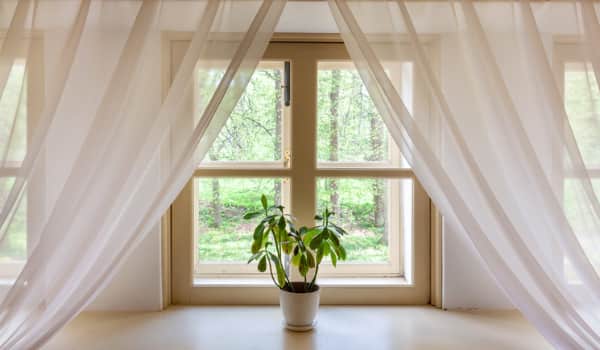Curtain length is a crucial design element that significantly impacts a room’s aesthetics and functionality. When it comes to how long curtains should hang below the window sill, there are various factors to consider, including the room’s style, the window’s height, and personal preference. Hanging curtains below the window sill can create an illusion of a larger window and enhance the overall visual appeal of the room. This discussion explores the different lengths of curtains below the window sill, benefits of each, and how to choose the most appropriate length to suit your room’s requirements and your personal style.
what is a window sill?

A window sill, also known as a window ledge. Is a structural element in architecture that forms the bottom edge Of a window frame. Typically, it’s a horizontal piece that extends outward from the window into the room as well as outside the building, serving both functional and aesthetic purposes.
Functionally, It helps to direct water away from the wall surface below the window during rain or snow. Protecting the structure of the building. Aesthetically, it can provide a finished look to the window or offer a small platform for décor elements like plants, photographs, or other objects.
It can be made of various materials, including wood, stone. Or metal, and its design can vary to complement the architectural style of the building.
Factors to Consider When Determining Curtain Length

When determining the right curtain length, the style of the room and the type of curtains are key considerations. The room’s overall design and aesthetics often inform the most suitable curtain length.
For instance, rooms with a formal or traditional ambiance typically pair well with longer, floor-length curtains. Whereas modern or casual rooms might look better with curtains that reach the sill or just below. The curtain style, whether it’s Roman, café, panel, or another type, can also steer your decision as certain styles inherently lend themselves better to particular lengths.
The second consideration is the height of the window and the wall. The scale of these elements can influence the optimal curtain length. For rooms with high ceilings or tall windows, longer curtains are usually a necessity to maintain balance and proportion within the room. Conversely, shorter windows or lower ceilings might appear more harmonious with curtains that sit at or just below the sill. Always remember to accurately measure from the curtain rod to the intended endpoint whether that’s the floor, the sill. Or somewhere in between – to achieve a fitting look.
Lastly, your personal preference and the desired aesthetic are pivotal in choosing the right curtain length. This choice should be an expression of your individual style and the vibe you want to create in your space. Some people might favor the informal appeal of sill-length curtains. While others may lean towards the more opulent and dramatic flair of curtain that pool on the floor.
By considering these elements, you can select a curtain length that brings both function and beauty to your room.
Standard Curtain Lengths

When it comes to standard curtain lengths. There are typically four categories: “sill length”, “below sill length”, “floor length”, and “puddling”.
- Sill length: curtains are those that reach precisely to the window sill. These curtains are commonly used in more casual settings or where a window sits above a radiator or another object that would obstruct a longer curtain. The typical measurements for sill length curtains can vary depending on the height of the window. But they generally stop directly at the bottom of the window sill.
- Below sill length: curtains hang approximately 15 cm (or 6 inches) below the window sill. These are a good choice when you want a lengthier curtain but don’t want it to reach the floor. This style is often used in informal spaces or in rooms where full-length curtains might feel overwhelming.
- Floor length: curtains extend from the curtain rod to just about half an inch above the floor. This is a traditional length for curtains and creates a formal and elegant look, making the ceilings appear taller and the room larger. The measurements for these curtains would depend on the height from the rod to the floor, less than half an inch to prevent the fabric from dragging.
- Puddling: curtains are those that extend onto the floor, creating a small ‘puddle’ of fabric. This style is often used in very formal or traditional settings, such as a dining or living room. The amount of puddling can vary based on personal preference, but typically, an extra 2-8 inches of length is added to the curtain measurement to achieve this effect. This style requires more fabric and more care to keep the curtain looking tidy. But it can create a dramatic, luxurious effect.
By understanding these different curtain lengths and the typical measurements for each. You can choose the one that best suits your room and your personal style.
Detailed Discussion: Curtains Hanging Below Window Sill

Curtains hanging below the window sill offer several advantages. Including enhancing the perception of space, providing better control over light and privacy, and lending a seamless aesthetic to the room.
These curtain lengths are often favored in areas where privacy is paramount, like bedrooms and living rooms, and in formal or elegant design schemes due to their added touch of sophistication.
As for the specific length, the industry-standard “below sill length” is approximately 15 cm (or 6 inches) below the window sill.
However, for a more dramatic look, a “floor length” curtain that hovers half an inch above the floor. Or “puddling” curtains that create a fabric ‘puddle’ on the floor, are also options. These lengths can be adjusted based on personal preference, room style, and practical considerations regarding curtain maintenance.
Choosing the Right Curtain Length for Your Space

Selecting the appropriate curtain length is a crucial aspect of room decor. And if you’re considering curtains that hang below the window sill, accurate measurement is key. Start the measurement from the curtain rod to the point where you want the curtains to end. This could be anywhere from a few inches below the sill for a casual look to floor length for a formal appearance.
Always add a few extra inches to your measurement to account for the curtain hem. Key factors to consider when choosing the length include light control and privacy – a longer curtain can offer more of both. Additionally, longer curtains can create an illusion of greater room height, contributing to a sense of spaciousness.
When selecting curtain material and color, consider the overall style and color scheme of your room. Lighter materials like cotton or linen can create a casual and airy feel, which pairs well with a shorter curtain length.
Heavier materials like velvet or brocade are suited for longer, floor-length curtain and create a more formal, dramatic effect. As for color, a hue that complements your room’s palette can enhance the overall design. While a contrasting color can create a striking visual interest.
Remember, the material and color should not only match the chosen length but also contribute positively to the overall ambiance of the room.
Maintenance and Care for Curtains Hanging Below the Window Sill

Maintaining and caring for curtains that hang below the window sill requires regular attention to ensure their longevity. These curtains should ideally be vacuumed or lightly dusted on a weekly basis to prevent dust and dirt buildup. If the fabric is washable, follow the manufacturer’s instructions for either machine or hand washing.
For non-washable fabrics, consider professional dry cleaning at least once a year. One potential challenge with longer curtains is that they are more likely to gather dust and dirt from the floor, especially if they’re “puddling” curtains. To address this, ensure regular cleaning and avoid dragging them across the floor when opening or closing. Also, be mindful of any pets that might claw or chew at the fabric, as longer curtains are more accessible to them.
Protective measures might be required, such as training pets to stay away or placing a pet deterrent near the curtains. By following these tips, you can help ensure that your curtains remain a beautiful addition to your room for years to come.
Do long curtains hinder window opening?
Long curtains can potentially interfere with the operation of windows, but much depends on the specific window and curtain setup. If the curtains are heavy or voluminous and not held back with tiebacks or holdbacks. They could obstruct the window when you’re trying to open or close it.
This is particularly true for windows that open inward, such as casement windows. However, with the appropriate hardware or curtain design, such as tiebacks, curtain wands, or panel glide systems, this issue can be effectively managed.
It’s also worth noting that in many cases. The aesthetic and functional benefits of longer curtains, such as improved light control, enhanced privacy. And increased perceived room height, can outweigh the minor inconvenience of possible obstruction.
Which curtain styles look better when hanging below the window sill?
Several curtain styles look particularly elegant when hanging below the window sill. Floor-length drapes, for example, offer a timeless elegance suitable for living rooms, dining rooms, or bedrooms, particularly when crafted from luxe materials like velvet or silk. Tab top and eyelet curtains also work well in this longer length. Especially in more casual or contemporary spaces, due to their simple, unadorned style.
For a romantic, traditional, or shabby chic style room, rod-pocket curtains or pinch-pleated drapes that reach below the sill or even puddle on the floor can add a sense of drama and luxury.
Furthermore, curtains with a pattern or vibrant color can make a striking statement when allowed to extend beyond the window sill. As always, the best choice depends on the room’s overall decor, the window’s size and shape, and your personal aesthetic preferences.
The final thought
The choice of curtain length, particularly those that hang below the window sill. Is a significant aspect of room decor that impacts both the aesthetics and function of your space. We’ve discussed how these curtains can enhance the perception of space, improve light control and privacy. And complement various interior design styles.
We also addressed how to accurately measure such curtains. The considerations in choosing curtain material and color, and tips for their maintenance and care. While longer curtains may present some challenges, such as potential interference with window operation or increased maintenance needs. These can generally be mitigated with thoughtful care and suitable accessories. Ultimately, choosing the right curtain length is about balancing the visual appeal with practical considerations, creating a space that feels both comfortable and personalized to your aesthetic preferences.




